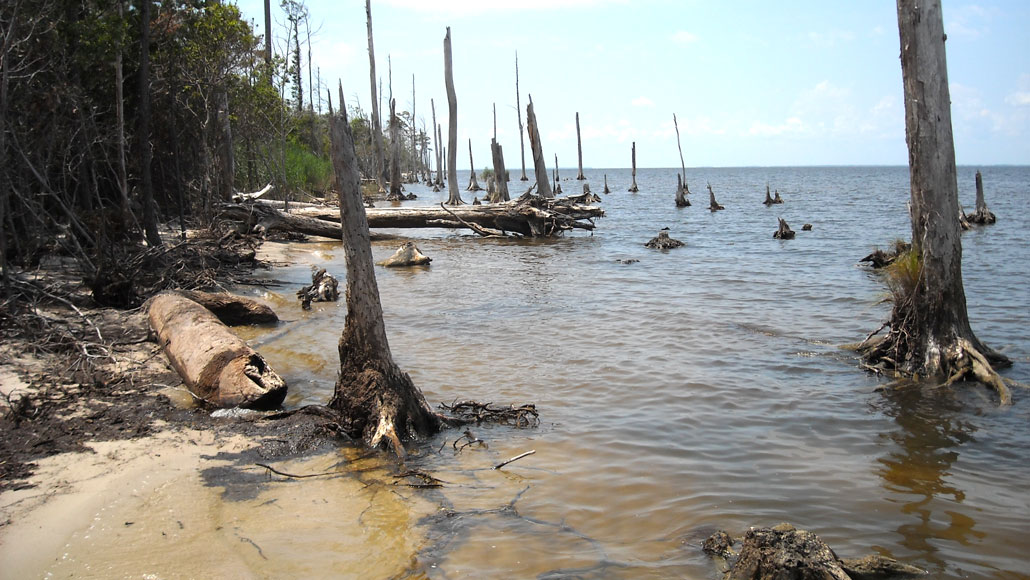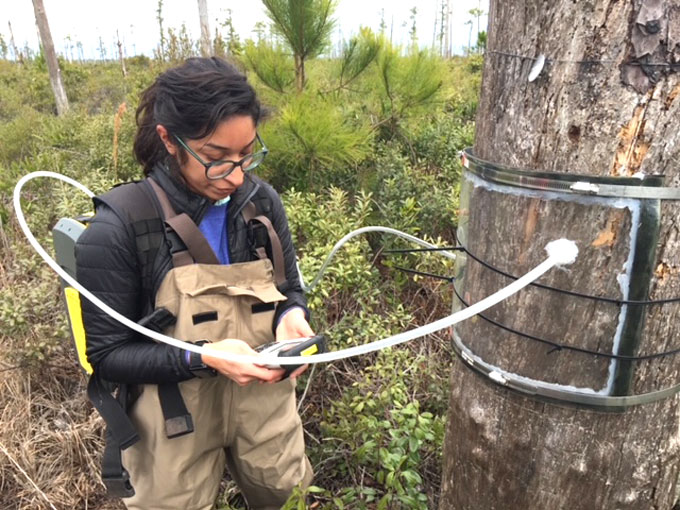‘Tree farts’ make up about a fifth of greenhouse gases from ghost forests
Those forests are drowned woodlands that emit heat-trapping gases as their trees decay

Ghost forests, like this one in North Carolina, are coastal woodlands drowned by sea level rise. These dead woodlands emit heat-trapping gases from their soils and dead trees.
M. Ardón
If a tree farts in the forest, does it make a sound? No. But it does add a smidge of carbon dioxide and other greenhouse gases into the air.
A team of ecologists measured these gases, or “tree farts,” released by dead trees in ghost forests. These spooky woodlands form when rising sea levels drown a forest, leaving behind a marsh full of skeletal dead trees. The new data suggest these trees generate about one-fifth of the greenhouse gases from ghost forests. The other emissions come from the soggy soils. Researchers report their findings online May 10 in Biogeochemistry.
Ghost forests are expected to expand as climate change raises sea levels. So scientists have been curious how much climate-warming gas these phantom ecosystems spew.
Over long periods, ghost forests could actually help draw carbon out of the air, says Keryn Gedan. The reason: Wetlands can store a lot of carbon in their soils, she says. Gedan is a coastal ecologist who wasn’t involved in the study. She works at George Washington University in Washington, D.C. It takes a while for carbon to build up in wetlands. In the meantime, dead trees in ghost forests give off greenhouse gases as they decay. That’s why in the short term, she says, ghost forests can pose an important source of carbon emissions.
Researchers used tools that sniffed for tree farts in five ghost forests. These forests line the coast of the Albemarle-Pamlico Peninsula in North Carolina. “It’s kind of eerie” out there, says Melinda Martinez. But this wetland ecologist ain’t afraid of no ghost forest. In 2018 and 2019, she trekked through ghost forest with a portable gas analyzer on her back. It measured greenhouse gases wafting off trees and soils. “I definitely looked like a ghostbuster,” Martinez recalls. She did this research while studying at North Carolina State University (NCSU) in Raleigh.

Her measurements revealed how ghost forests pass gas into the atmosphere. Soils gave off most of the gases. Each square meter of ground (about 10.8 square feet) gave off an average 416 milligrams (0.014 ounce) of carbon dioxide per hour. The same area gave off smaller amounts of other greenhouse gases. For instance, each square meter of soil expelled an average 5.9 milligrams (0.0002 ounce) of methane and 0.1 milligram of nitrous oxide per hour.
Dead trees released about one-fourth as much as soils.
Those dead trees “don’t emit a ton, but they are important” to a ghost forest’s overall emissions, says Marcelo Ardón. He’s an ecosystems ecologist and biogeochemist at NCSU who worked with Martinez. Ardón came up with the term “tree farts” to describe the dead trees’ greenhouse-gas emissions. “I have an 8-year-old and an 11-year-old,” he explains. “Fart jokes are what we talk about.” But the analogy is rooted in biology, too. Actual farts are caused by microbes in the body. Likewise, tree farts are created by microbes in decaying trees.
In the grand scheme of things, releases of greenhouse gases from ghost forests may be minor. Tree farts, for instance, have nothing on cow burps. In just one hour, a single cow can emit up to 27 grams of methane (0.001 ounce). That’s a far more potent greenhouse gas than CO2. But accounting for even small emissions is important to get a complete picture of where climate-warming gases come from, says Martinez. So scientists shouldn’t turn up their noses at ghost-tree farts.







